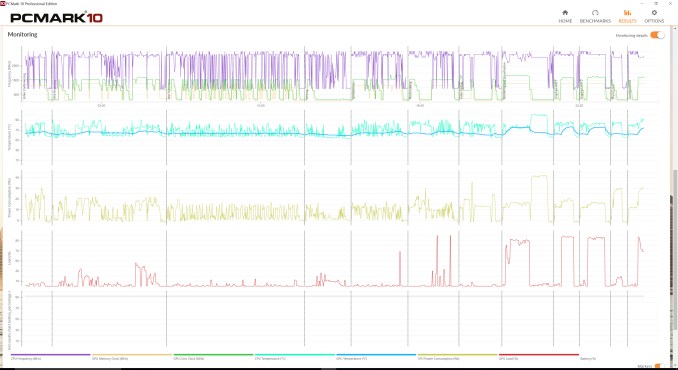Test Driving Futuremark's PCMark 10 Benchmark
by Ganesh T S on June 5, 2017 6:00 AM EST- Posted in
- Systems
- Futuremark
- Benchmarks
- PCMark 10
Concluding Remarks
Futuremark's PCMark 10 is a welcome update to the tried and tested PCMark 8 benchmark. The new version solves many of the pain points that reviewers had to either bear or work-around in PCMark 8. The run-time of the benchmark has been shortened compared to the older version. The workloads are more clearly defined now. Compared to the generic 'Home', 'Creative', and 'Work' scores, we have 'Essentials', 'Productivity', 'Gaming', and 'Digital Content Creation'. Each of the low-level workloads is reported with its own score. This makes it easier to compare systems for specific tasks. Custom workloads are also available. Some of the new low-level workloads include application start-up times, and rendering and visualization. The command line is the interface of choice for professional users and reviewers, and we are happy to report that this aspect has received a much-needed overhaul in PCMark 10. Results can be exported directly in either XML or PDF format, and a lot of confusing options resulting from PCMark 8's 'OpenCL-accelerated' mode are now removed.
The version of PCMark 10 that we evaluated (1.0.1198) does have some scope for improvement. While VP9 and H.264 decode are part of the web browsing benchmarks, HEVC is oddly absent (given that Netflix is using HEVC right now for 4K streaming). Similar to the previous version, PCMark 10 also allows monitoring and recording of various hardware parameters (such as the CPU and GPU clock frequencies, temperature, power consumption etc.) during the processing of the benchmark. This feature is especially useful to identify whether the system throttles under normal consumer workloads. Unfortunately, the recorded information is not truly portable - it can be viewed only by loading the results in the PCMark 10 application.
Yet another aspect that needs improvement is the difference in the level of details between results exported in the XML and PDF formats. While the former includes all low-level workload scores, the PDF only breaks down the scores up to the four distinct workload sets. Another workload / score that we missed in moving from PCMark 8 to PCMark 10 is the storage segment evaluation. While the new application start-up workload does reflect the storage sub-system performance to some extent, PCMark 8's evaluation of that aspect was much more comprehensive.
Futuremark's PCMark 10 is a vendor-neutral benchmark that can help system builders in pitching the right system configuration to high-volume PC buyers (businesses and enterprises). Its main competitor in the space is BAPCo's SYSmark 2014 SE. Both of them use real-world workloads to deliver a measure of the system capabilities. Based on our experience with both benchmarks, we believe that PCMark 10 would do well to gather some aspects of BAPCo's offerings. Ensuring consistent OS settings across all benchmark runs on different systems and adding energy consumption data to get an idea of the power efficiency of the system would be nice additions. On the other hand, the ease of processing PCMark 10 is miles ahead of SYSmark 2014 SE. PCMark 10 also includes rendering and gaming workloads, which is not available in SYSmark 2014 SE. From the viewpoint of our system reviews, we believe presenting results from both benchmarks will provide readers with more insight into the performance of the system.











18 Comments
View All Comments
aprilrussell - Tuesday, May 22, 2018 - link
I think HVEC is not used because it is not supported on Windows 7 by the OS.Visit: http://fivenightsat-freddys.com
Draven31 - Tuesday, June 6, 2017 - link
So what is the video editing software? looks like it certainly isn't something GPU- accelerated... what resolution video? what bit depth? what codec? what data rate? these can make massive differences.Of course, other sites will just use it sight unseen...
FMJarnis - Thursday, June 22, 2017 - link
PCMark 10 technical guide covers all that:https://www.futuremark.com/downloads/pcmark10-tech...
Uses FFMPeg. It is GPU accelerated if your system has GPU acceleration support for Windows Media Foundation. It uses Intel QuickSync if it is present and driver supports it. A part of it also uses OpenCL which is GPU accelerated if system supports that. See Page 57 of the technical guide for full details.
ET - Tuesday, June 6, 2017 - link
Why is the gaming score lower for the high performance profile? That's counter-intuitive, and goes against all the other tests.nathanddrews - Tuesday, June 6, 2017 - link
The DAS test bench uses a 6600K with IGP, not a discrete GPU. My guess is that it ended up being thermally constrained (throttled) when left on performance mode. Now if they used a discrete GPU, it would likely be the fastest mode.nathanddrews - Tuesday, June 6, 2017 - link
To be clear - the IGP heats up the die package more than when the CPU alone is working.Link to the DAS test bed:
http://www.anandtech.com/show/10057/samsung-portab...
JohnLinc - Monday, June 12, 2017 - link
thisistotesthedelayforwebJoe Shmoe - Saturday, August 19, 2017 - link
Entire article is laid out as a confusing mess.There is no 'Constant' to keep the reader centered (who knows the capabilities/ difference between any of these machines, unless they own at least 3, for Cheeses sake?)
On top of that the machines(who?) move position in the graphs..
I thought the point of this exercise was to show how this tool may be of comparable use, but without a reference to a known machine running pc mark 8 (and scores to compare) this article may as well be about the mating habits of a newly discovered sewer bred crocodile.